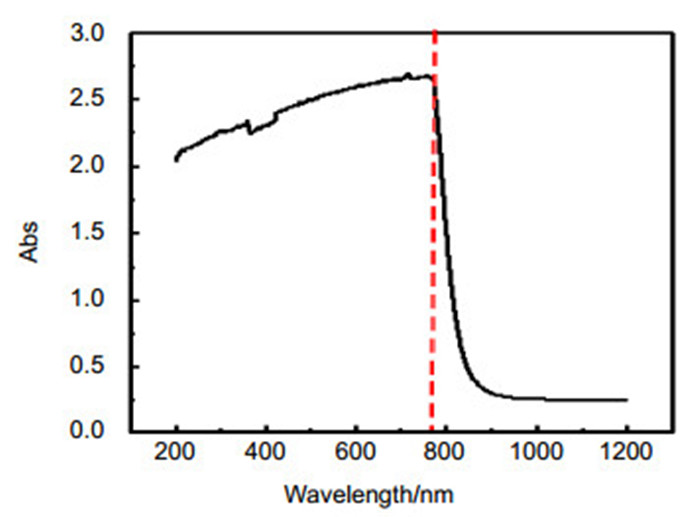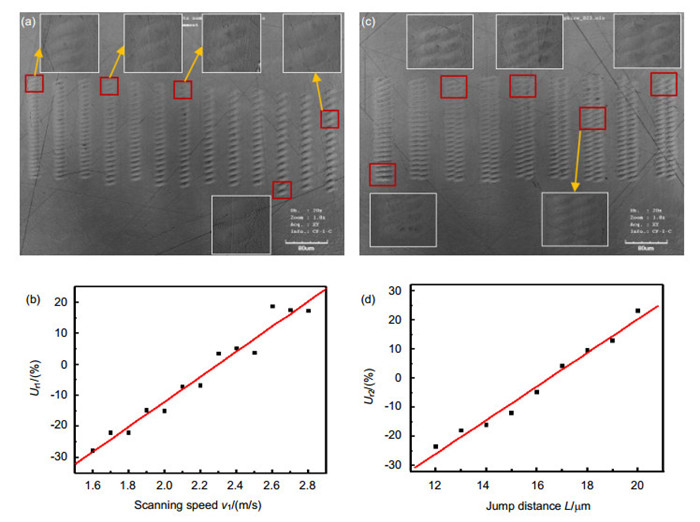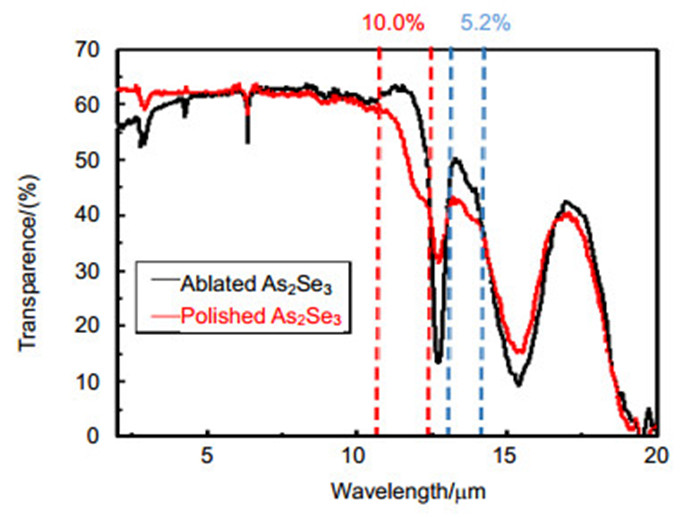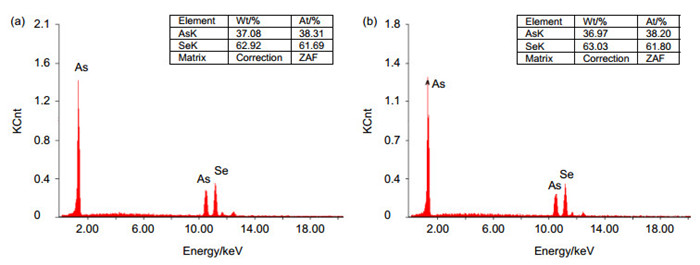Picosecond laser microfabrication of infrared antireflective functional surface on As2Se3 glass
-
摘要
采用紫外皮秒激光在As2Se3玻璃表面以线扫描形式快速制备大面积周期性点阵式增透微结构,获得了红外透光性能提高的硫系玻璃样品。研究确定了As2Se3玻璃的激光刻蚀阈值,并研究设计了合适线扫描工艺方法。所制样品相对于原样在波长11.0μm~12.4μm范围内,透过率平均提高10.0%;波长13.0μm~14.2μm范围内,透过率平均提高5.2%。激光扫描制备方法没有破坏样品表面原有的浸润性,整个制备过程均在空气开放环境下进行,成本低,工艺可控性强,效率高,制备8mm×8mm的表面微结构,仅用时3.65s,且表面微结构单元尺寸及间距可按材料应用需求调控。分析表明,当激光能量较低时,对该硫系玻璃的去除以“冷加工”为主,不会有明显的热效应,得到微结构的硫系玻璃表面元素组成未发生改变;激光能量较高时,会存在一定的热效应,使得刻蚀点出现熔融态,在微坑边缘出现凸起或翻边。

-
关键词:
- 皮秒激光 /
- As2Se3硫系玻璃 /
- 表面微结构 /
- 增透 /
- 接触角
Abstract
Large-scale periodic dot matrix anti-reflective microstructures were fabricated on the surface by using UV picosecond laser with rapid line scanning to improve the infrared transmittance of As2Se3 glass. In the study, the laser ablation threshold of As2Se3 glass was concluded and the optimal line scanning method was designed. The transmittance of the fabricated chalcogenide glass increased about 10.0 % and 5.2% in wavelength ranged from 11.0 μm~12.4 μm and 13.0 μm~14.2 μm, respectively. In addition, the wettability of the glass was not damaged by laser scanning. The processing was carried out in air condition showing low cost, high controllability and high efficiency. It only took 3.65 s to finish the fabrication of 8 mm×8 mm surface structures. Both the size and space of the surface microstructure unit can be controlled according to the application requirement. The removal of the chalcogenide glass induced by laser was mainly based on "cold fabrication" in which no obvious thermal effects inducing the element change on the surface were observed. Higher laser energy could induce obvious thermal effect resulting in melting of the ablation points and bump of the crater edges.
-
Key words:
- picosecond laser /
- As2Se3 chalcogenide glass /
- surface micro-structure /
- antireflection /
- contact angle
-
Overview

Chalcogenide glasses are formed of chalcogen of S, Se, Te with doping of a certain of other metal elements. Due to the lower refractive index, temperature coefficient and good infrared transmittance, it has been recognized as the ideal materials for a new generation temperature non-refrigerated infrared optical system. In order to decrease the large reflection losses, researches on multi-layer thin-film coatings for anti-reflection (AR) with good performance were performed. However, disadvantages of the method are needed to be overcome, such as high costs and short lifetimes. Recently, surface micro-structures have been shown to be a good alternative potential to multi-layer thin-film AR coatings in many infrared and visible-band applications.
Large-scale periodic dot matrix anti-reflective microstructures were fabricated on the surface by using UV picosecond laser with rapid line scanning to improve the infrared transmittance of As2Se3 glass. In the study, the laser ablation threshold of As2Se3 glass was concluded and the optimal line scanning method was designed. The transmittance of the fabricated chalcogenide glass increased about 10.0 % and 5.2 % in wavelength ranged from 11.0 μm~12.4 μm and 13.0 μm~14.2 μm, respectively. In addition, the static contact angles of the treated samples were increased from 71° to 84° of the untreated ones, which means there was no significant change in the wettability. The processing was carried out in air condition showing low cost, high controllability and high efficiency. Since the ultra-short pulse laser duty ratio is very small, the laser rapid scanning can be used to achieve single-pulse point by point processing on the sample surface. It only took 3.65 s to finish the fabrication of 8 mm×8 mm surface structures. Both the size and space of the surface microstructure unit can be controlled according to the application requirement. The morphology of the surface microstructure is controllable by changing the laser parameters (single pulse energy, defocus, etc.) and interval depends on the laser scanning speed, laser pulse frequency and scanning path. The removal of the chalcogenide glass induced by laser was mainly based on "cold fabrication" in which no obvious thermal effects inducing the element change on the surface were observed. Higher laser energy could induce obvious thermal effect resulting in melting of the ablation points and bump of the crater edges. The results can be provided as a guide for the laser rapid fabrication of anti-reflection micro-structure, which is suitable for the applications in infrared optical material and other optical materials in a low-cost and controllable way.
-

-
图 7 (a) 不同相离率Ur1微坑形貌. (b)相离率Ur1与扫描速度v1关系. (c)不同相离率Ur2微坑形貌. (d)相离率Ur2与跳转距L离关系.
Figure 7. (a) Ablation morphology of crater with different Ur1. (b) The relationship between Ur1 and scanning speed v1. (c) Ablation morphology of crater with different Ur2. (d) The relationship between Ur2 and jump distance L.
表 1 As2Se3玻璃基本特征参数.
Table 1. Basic parameters of As2Se3 glasses.
密度/(g/cm3) 膨胀系数/(×10-6/K) 转变温度/(℃) 比热/(J/kg) 热导率/(W/mK) 色散(参考值) 折射率 折射率温度系数(参考值) 4.16±0.01 20.7±0.1 (30℃-100℃) 185±5 0.33 0.24 168(4.0 μm) 2.795(4.0 μm) 30×10-6/K(3.4 μm) 161(10.6μm) 2.778(10.6 μm) 36×10-6/K(10.6 μm) -
参考文献
[1] 戴世勋, 陈惠广, 李茂忠, 等.硫系玻璃及其在红外光学系统中的应用[J].红外与激光工程, 2012, 41(4): 847‒852. http://www.cnki.com.cn/Article/CJFDTOTAL-HWYJ201204003.htm
Dai Shixun, Chen Huiguang, Li Maozhong, et al. Chalcogenide glasses and their infrared optical applications[J]. Infrared and Laser Engineering, 2012, 41(4): 847‒852. http://www.cnki.com.cn/Article/CJFDTOTAL-HWYJ201204003.htm
[2] Goubet E, Katz J, Porikli F. Pedestrian tracking using thermal infrared imaging[J]. Proceedings of SPIE, 2006, 6206: 62062C. http://d.old.wanfangdata.com.cn/Periodical/hwyjggc201204004
[3] 付秀华, 姜洪妍, 张静, 等.基于硫系玻璃的短中波红外减反膜研制[J].中国激光, 2017, 44(9): 903002. http://kns.cnki.net/KCMS/detail/detail.aspx?filename=jjzz201709019&dbname=CJFD&dbcode=CJFQ
Fu Xiuhua, Jiang Hongyan, Zhang Jing, et al. Preparation of short and medium wave infrared anti-reflective coating based on chalcogenide glass[J]. Chinese Journal of Lasers, 2017, 44(9): 903002. http://kns.cnki.net/KCMS/detail/detail.aspx?filename=jjzz201709019&dbname=CJFD&dbcode=CJFQ
[4] Bernhard C G, Miller W H. A corneal nipple pattern in insect compound eyes[J]. Acta Physiologica Scandinavica, 1962, 56(3‒4): 385‒386. doi: 10.1111/apha.1962.56.issue-3-4 http://cn.bing.com/academic/profile?id=85e2a9a66b412f5b222459888847c74c&encoded=0&v=paper_preview&mkt=zh-cn
[5] Raguin D H, Morris G M. Antireflection structured surfaces for the infrared spectral region[J]. Applied Optics, 1993, 32(7): 1154‒1167. doi: 10.1364/AO.32.001154 http://cn.bing.com/academic/profile?id=376c9d67a277cb41dcde18ae85dcaf81&encoded=0&v=paper_preview&mkt=zh-cn
[6] Denatale J F, Hood P J, Flintoff J F, et al. Fabrication and characterization of diamond moth eye antireflective surfaces on Ge[J]. Journal of Applied Physics, 1992, 71(3): 1388‒1393. doi: 10.1063/1.351259 http://cn.bing.com/academic/profile?id=a984ce3ae21707b87d515242b20a3361&encoded=0&v=paper_preview&mkt=zh-cn
[7] Southwell W H. Pyramid-array surface-relief structures producing antireflection index matching on optical surfaces[J]. Journal of the Optical Society of America A, 1991, 8(3): 549‒553. http://cn.bing.com/academic/profile?id=5b41ee24896328fa2fa10f00b4bca0a3&encoded=0&v=paper_preview&mkt=zh-cn
[8] Wilson S J, Hutley M C. The optical properties of 'moth eye' antireflection surfaces[J]. Optica Acta: International Journal of Optics, 1982, 29(7): 993‒1009. doi: 10.1080/713820946 http://cn.bing.com/academic/profile?id=d4bc432c3413722022beedd95b43096b&encoded=0&v=paper_preview&mkt=zh-cn
[9] MacLeod B D, Hobbs D S, Sabatino E. Moldable AR microstructures for improved laser transmission and damage resistance in CIRCM fiber optic beam delivery systems[J]. Proceedings of SPIE, 2011, 8016: 80160Q. doi: 10.1117/12.883281 http://cn.bing.com/academic/profile?id=10916729eec350968866320779b97e87&encoded=0&v=paper_preview&mkt=zh-cn
[10] Hobbs D S, MacLeod B D, Riccobono J R. Update on the development of high performance anti-reflecting surface relief micro-structures[J]. Proceedings of SPIE, 2007, 6545: 65450Y. doi: 10.1117/12.720672 https://www.spiedigitallibrary.org/conference-proceedings-of-spie/6545/1/Update-on-the-development-of-high-performance-anti-reflecting-surface/10.1117/12.720672.full
[11] Hobbs D S, MacLeod B D. Design, fabrication, and measured performance of anti-reflecting surface textures in infrared transmitting materials[J]. Proceedings of SPIE, 2005, 5786: 349‒364. doi: 10.1117/12.604532 http://cn.bing.com/academic/profile?id=43cc5f81f5b01fd678c6862faa886de5&encoded=0&v=paper_preview&mkt=zh-cn
[12] 冯献飞, 邓军, 刘明, 等.用于短波红外探测器的微透镜阵列制作[J].光电工程, 2017, 44(6): 633‒637. http://www.oejournal.org/J/OEE/Article/Details/A170830000053/CN
Feng Xianfei, Deng Jun, Liu Ming, et al. Microlens array for shortwave infrared detectors[J]. Opto-Electronic Engineering, 2017, 44(6): 633‒637. http://www.oejournal.org/J/OEE/Article/Details/A170830000053/CN
[13] 苗向阳. 太阳能玻璃的加工及应用技术研究[D]. 北京: 中国建筑材料科学研究总院, 2009.
Miao Xiangyang. Study of treatment and application of solar glass[D]. Beijing: China Building Materials Academy, 2009.
[14] Abbott M, Cotter J. Optical and electrical properties of laser texturing for high-efficiency solar cells[J]. Progress in Photovoltaics: Research and Applications, 2006, 14(3): 225‒235. doi: 10.1002/(ISSN)1099-159X http://cn.bing.com/academic/profile?id=c22ec7f0d43f3613bb68c3f58245d581&encoded=0&v=paper_preview&mkt=zh-cn
[15] Wang Quanji, Zhou Weidong. Direct fabrication of cone array microstructure on monocrystalline silicon surface by femtosecond laser texturing[J]. Optical Materials, 2017, 72: 508‒512. doi: 10.1016/j.optmat.2017.06.046 https://www.sciencedirect.com/science/article/pii/S092534671730424X
[16] 何超. 光伏玻璃表面激光织构化技术研究[D]. 北京: 北京工业大学, 2012.
He Chao. Study on laser texturization on the surface of solar glass[D]. Beijing: Beijing University of Technology, 2012.
[17] Ji Lingfei, Lv Xiaozhan, Wu Yan, et al. High performance light trapping structures for Si-based photoelectronics fabricated by hybrid picosecond laser irradiation and chemical corrosion[J]. Proceedings of SPIE, 2015, 9351: 93511R. doi: 10.1117/12.2077959 https://www.spiedigitallibrary.org/redirect/proceedings/proceeding?doi=10.1117/12.2077959
[18] Ji Lingfei, Lv Xiaozhan, Wu Yan, et al. Hydrophobic light-trapping structures fabricated on silicon surfaces by picosecond laser texturing and chemical etching[J]. Journal of Photonics for Energy, 2015, 5(1): 053094. doi: 10.1117/1.JPE.5.053094 https://www.spiedigitallibrary.org/redirect/photonicsforenergy/article?doi=10.1117/1.JPE.5.053094
[19] 吕晓占, 季凌飞, 吴燕, 等.皮秒激光-化学复合法制备高效减反射晶硅表面微结构研究[J].中国激光, 2015, 42(4): 0403006. http://www.opticsjournal.net/upload/post/articles/0403006.pdf
Lv Xiaozhan, Ji Lingfei, Wu Yan, et al. Fabrication of high performance anti-reflection silicon surface by picosecond laser scanning irradiation with chemical corrosion[J]. Chinese Journal of Lasers, 2015, 42(4): 0403006. http://www.opticsjournal.net/upload/post/articles/0403006.pdf
[20] Liu J M. Simple technique for measurements of pulsed Gaussian-beam spot sizes[J]. Optics Letters, 1982, 7(5): 196‒198. doi: 10.1364/OL.7.000196 http://cn.bing.com/academic/profile?id=fab10e71a1999b647be3854e7e9148dd&encoded=0&v=paper_preview&mkt=zh-cn
[21] Li Jun, Drabold D A. First-principles molecular-dynamics study of glassy As2Se3[J]. Physical Review B, 2000, 61(18): 11998‒12004. doi: 10.1103/PhysRevB.61.11998 http://cn.bing.com/academic/profile?id=eb6fe92ecb491db589c812d96ded6592&encoded=0&v=paper_preview&mkt=zh-cn
[22] 董亭亭. 仿生蛾眼抗反射微结构光学机理研究[D]. 长春: 长春理工大学, 2016.
Dong Tingting. Research on optical mechanism of bionic moth-eye antireflection microstructure[D]. Changchun: Changchun University of Science and Technology, 2016.
[23] 李林翰. 红外窗口用硫化锌表面亚波长结构的制备与保护[D]. 哈尔滨: 哈尔滨工业大学, 2015.
Li Linhan. Preparation and protection of ZnS surface sub-wavelength structure for infrared window[D]. Harbin: Harbin Institute of Technology, 2015.
[24] 陈鹏杰. 亚波长结构宽波段抗反射工艺的研究[D]. 成都: 电子科技大学, 2013.
Chen Pengjie. Study on broadband antireflective subwavelength structures process[D]. Chengdu: University of Electronic Science and Technology of China, 2013.
[25] You Chenyang, Dai Shixun, Zhang Peiqing, et al. Mid-infrared femtosecond laser-induced damages in As2S3 and As2Se3 chalcogenide glasses[J]. Scientific Reports, 2017, 7(1): 6497. doi: 10.1038/s41598-017-06592-3
[26] Cassie A B D, Baxter S. Wettability of porous surfaces[J]. Transactions of the Faraday Society, 1944, 40: 546‒551. doi: 10.1039/tf9444000546 http://cn.bing.com/academic/profile?id=eb8910393acac9b3564af3ff837360ba&encoded=0&v=paper_preview&mkt=zh-cn
-
访问统计


 E-mail Alert
E-mail Alert RSS
RSS

 下载:
下载:













